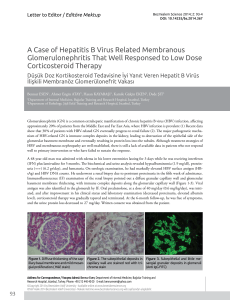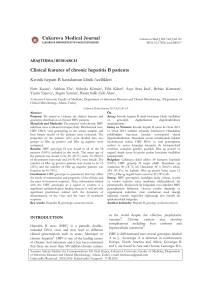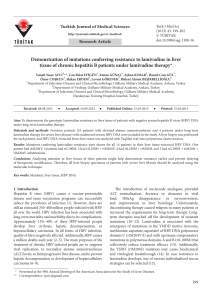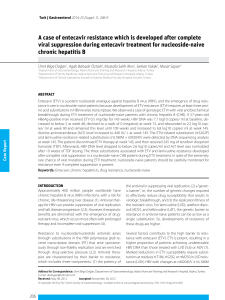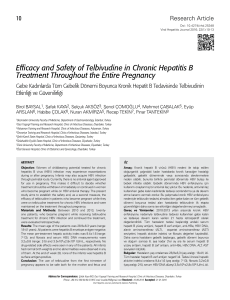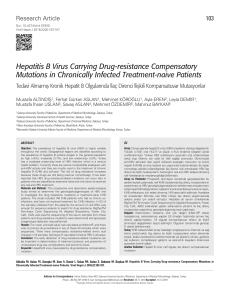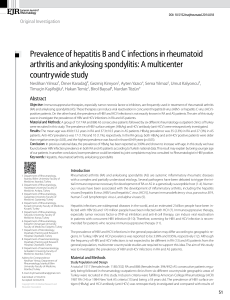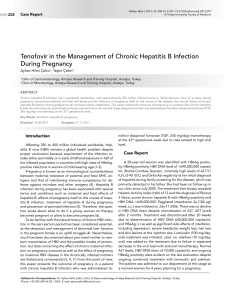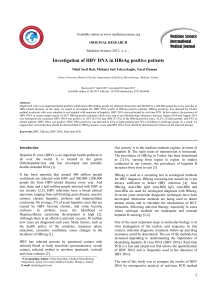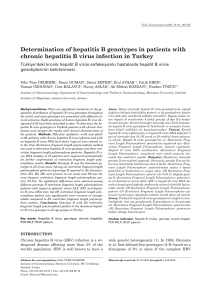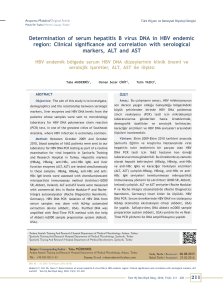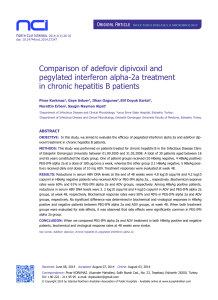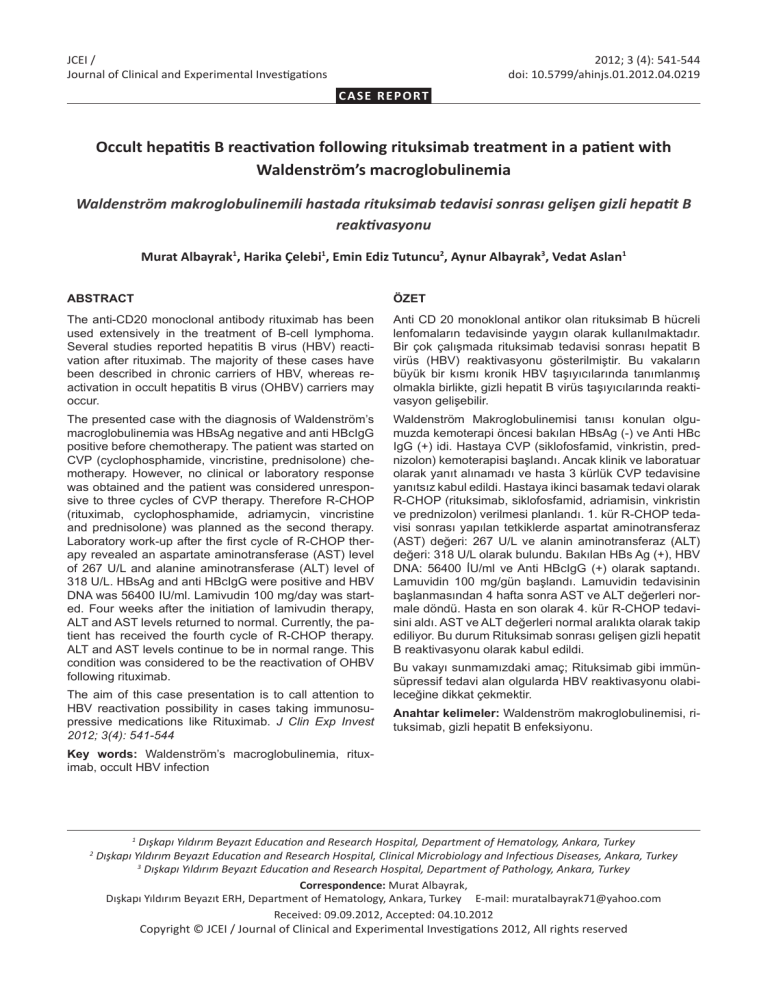
JCEI / Albayrak et al. Hepatitis B reactivation following rituksimab treatment
2012; 3 (4): 541-544
541
Journal of Clinical and Experimental Investigations doi: 10.5799/ahinjs.01.2012.04.0219
CASE REPORT
Occult hepatitis B reactivation following rituksimab treatment in a patient with
Waldenström’s macroglobulinemia
Waldenström makroglobulinemili hastada rituksimab tedavisi sonrası gelişen gizli hepatit B
reaktivasyonu
Murat Albayrak1, Harika Çelebi1, Emin Ediz Tutuncu2, Aynur Albayrak3, Vedat Aslan1
ABSTRACT
ÖZET
The anti-CD20 monoclonal antibody rituximab has been
used extensively in the treatment of B-cell lymphoma.
Several studies reported hepatitis B virus (HBV) reactivation after rituximab. The majority of these cases have
been described in chronic carriers of HBV, whereas reactivation in occult hepatitis B virus (OHBV) carriers may
occur.
Anti CD 20 monoklonal antikor olan rituksimab B hücreli
lenfomaların tedavisinde yaygın olarak kullanılmaktadır.
Bir çok çalışmada rituksimab tedavisi sonrası hepatit B
virüs (HBV) reaktivasyonu gösterilmiştir. Bu vakaların
büyük bir kısmı kronik HBV taşıyıcılarında tanımlanmış
olmakla birlikte, gizli hepatit B virüs taşıyıcılarında reaktivasyon gelişebilir.
The presented case with the diagnosis of Waldenström’s
macroglobulinemia was HBsAg negative and anti HBcIgG
positive before chemotherapy. The patient was started on
CVP (cyclophosphamide, vincristine, prednisolone) chemotherapy. However, no clinical or laboratory response
was obtained and the patient was considered unresponsive to three cycles of CVP therapy. Therefore R-CHOP
(rituximab, cyclophosphamide, adriamycin, vincristine
and prednisolone) was planned as the second therapy.
Laboratory work-up after the first cycle of R-CHOP therapy revealed an aspartate aminotransferase (AST) level
of 267 U/L and alanine aminotransferase (ALT) level of
318 U/L. HBsAg and anti HBcIgG were positive and HBV
DNA was 56400 IU/ml. Lamivudin 100 mg/day was started. Four weeks after the initiation of lamivudin therapy,
ALT and AST levels returned to normal. Currently, the patient has received the fourth cycle of R-CHOP therapy.
ALT and AST levels continue to be in normal range. This
condition was considered to be the reactivation of OHBV
following rituximab.
Waldenström Makroglobulinemisi tanısı konulan olgumuzda kemoterapi öncesi bakılan HBsAg (-) ve Anti HBc
IgG (+) idi. Hastaya CVP (siklofosfamid, vinkristin, prednizolon) kemoterapisi başlandı. Ancak klinik ve laboratuar
olarak yanıt alınamadı ve hasta 3 kürlük CVP tedavisine
yanıtsız kabul edildi. Hastaya ikinci basamak tedavi olarak
R-CHOP (rituksimab, siklofosfamid, adriamisin, vinkristin
ve prednizolon) verilmesi planlandı. 1. kür R-CHOP tedavisi sonrası yapılan tetkiklerde aspartat aminotransferaz
(AST) değeri: 267 U/L ve alanin aminotransferaz (ALT)
değeri: 318 U/L olarak bulundu. Bakılan HBs Ag (+), HBV
DNA: 56400 İU/ml ve Anti HBcIgG (+) olarak saptandı.
Lamuvidin 100 mg/gün başlandı. Lamuvidin tedavisinin
başlanmasından 4 hafta sonra AST ve ALT değerleri normale döndü. Hasta en son olarak 4. kür R-CHOP tedavisini aldı. AST ve ALT değerleri normal aralıkta olarak takip
ediliyor. Bu durum Rituksimab sonrası gelişen gizli hepatit
B reaktivasyonu olarak kabul edildi.
The aim of this case presentation is to call attention to
HBV reactivation possibility in cases taking immunosupressive medications like Rituximab. J Clin Exp Invest
2012; 3(4): 541-544
Bu vakayı sunmamızdaki amaç; Rituksimab gibi immünsüpressif tedavi alan olgularda HBV reaktivasyonu olabileceğine dikkat çekmektir.
Anahtar kelimeler: Waldenström makroglobulinemisi, rituksimab, gizli hepatit B enfeksiyonu.
Key words: Waldenström’s macroglobulinemia, rituximab, occult HBV infection
2
1
Dışkapı Yıldırım Beyazıt Education and Research Hospital, Department of Hematology, Ankara, Turkey
Dışkapı Yıldırım Beyazıt Education and Research Hospital, Clinical Microbiology and Infectious Diseases, Ankara, Turkey
3
Dışkapı Yıldırım Beyazıt Education and Research Hospital, Department of Pathology, Ankara, Turkey
Correspondence: Murat Albayrak,
Dışkapı Yıldırım Beyazıt ERH, Department of Hematology, Ankara, Turkey E-mail: [email protected]
Received: 09.09.2012, Accepted: 04.10.2012
Copyright
© JCEI / Journal of Clinical www.jceionline.org
and Experimental Investigations
2012, All rights
J Clin Exp Invest
Vol 3,reserved
No 4, December 2012
542
Albayrak et al. Hepatitis B reactivation following rituksimab treatment
INTRODUCTION
Hepatitis B virus (HBV) reactivation is a serious
complication of cytotoxic or immunosuppressive
therapies. The incidence of reactivation following
chemotherapy in chronic HBV carriers varies between 21 to 53%.1 An unknown number of subjects
in the general population harbor occult HBV infection, i.e. the presence of HBV genomes in the liver
in the absence of detectable amounts of HBsAg and
even of any other conventional markers of HBV infection in the blood.2 Occult HBV infection has been
known to reactivate under immunosuppression and
to cause episodes of acute hepatitis B.1 In this setting, routine detection of HBsAg before chemotherapy may not be sufficient.
We have presented a case diagnosed with
Waldenström’s macroglobulinemia developing an
occult reactivation of hepatitis B following rituximab
therapy and successfully treated with lamivudin.
This case was presented to draw attention to occult HBV infections and to state that there is an increased risk of occult HBV reactivation with the addition of rituximab to CHOP therapy.
R-CHOP treatment was planned with rituximab
375 mg/m2 (1 day), cyclophosphamide 750 mg/m2
(1 day), vincristine 1.4 mg/m2 (1 day), adriamycin
50 mg/m2 (1 day) and prednisolone 100 mg/day (5
days) in every 21 days. Five days after the first cycle of R-CHOP treatment the patient presented with
fatigue. Laboratory work-up revealed an aspartate
aminotransferase (AST) level of 267 U/L and alanine aminotransferase (ALT) level of 318 U/L. Abdominal ultrasonography was normal. HBsAg and
anti HBcIgG were found positive and HBV DNA was
56400 IU/ml. The patient was considered as having
reactivation of occult hepatitis B and lamivudin 100
mg/day was started. The ALT and AST levels of the
patient returned to normal after four weeks of lamivudin treatment and the HBV DNA level was 41 IU/
ml. Chemotherapy was continued and the patient
had received the fourth cycle of R-CHOP therapy
with normal liver enzymes. This rare condition was
considered to be reactivation of occult hepatitis B
following the administration of chemotherapy.
CASE REPORT
Forty-seven-year-old male patient presented with
nose bleeding, fatigue and headache. Physical
examination revealed hepatosplenomegaly and
peripheral lymphadenopathy. Laboratory work-up
revealed hemoglobin level of 12.8 g/dl, platelets
123.000/µL, c-reactive protein 20.1 mg/L (0-5), β2
microglobulin level of 5.69 g/L (1.09-2.53) and immunoglobulin M (IgM) level of 37.8 g/L (0.4-2.30).
Monoclonal gammapathy in protein electrophoresis
and IgM kappa monoclonal gammapathy in serumurine immune fixation was detected. Bone marrow
biopsy was carried out and diffuse infiltration with
lymphoplasmocytes was reported (Figure 1 and 2).
The patient was diagnosed as Waldenström’s Macroglobulinemia. Viral markers were studied before
induction of chemotherapy. HbsAg, anti HCV, anti
HIV were negative and anti HBc IgG was found to
be positive. CVP chemotherapy (cyclophosphamide, vincristine and prednisolone) was started.
Cyclophosphamide 750 mg/m2 (1 day), vincristine
2 mg/day (1 day) and prednisolone 100 mg/day (5
days) were given. A total of three cycles were administered in every three weeks. However, a clinical or laboratory response was not obtained. IgM
level was still high and monoclonal gammapathy
persisted in protein electrophoresis. The patient
was considered unresponsive to CVP therapy and
J Clin Exp Invest Figure 1. Bone marrow biopsy section from a patient with
waldenström macroglobulinemi shows an extensive diffuse infiltrate (H&E, X100)
Figure 2. This clonal bone marrow disorder is morphologically characterized by a neoplastic proliferation of
small lymphocytes, plasma cells, and plasmacytoid lymphocytes (H&E, X400)
www.jceionline.org Vol 3, No 4, December 2012
Albayrak et al. Hepatitis B reactivation following rituksimab treatment
DISCUSSION
Rituximab is a chimeric monoclonal antibody
against the protein CD20, which is commonly used
in the treatment of B cell lymphomas.3,4 Rituximab is
also an effective immunosuppressive agent which
may lead to HBV replication.5 Antracyclin based
chemotherapy regimens (such as cyclophosphamide, doxorubicin, vincristine and prednisone) with
the addition of rituximab (R-CHOP), forms the standard front line therapy in the treatment of CD 20 (+)
B cell lymphomas.6
Rituximab has been found to induce profound
and durable B-cell depletion. Although lysis of HBVinfected hepatocytes is mainly mediated by CD8+
cytotoxic T-cell immunity, B cells may also act as
antigen-presenting cells and prime cytotoxic Tcell–specific responses in HBV infection. The B cell
depletion due to rituximab may result in defective T
cell response to the HBV which may lead to the viral
replication.3 This is supported by the observation of
rituximab-induced severe or fatal cytomegalovirus
reactivation, parvovirus B19 infection, adenovirus
infection, and Pneumocystis carini pneumonia.4
HBV reactivation is a common complication in
HBsAg positive patients undergoing immunosuppressive anticancer therapy. On the other hand,
HBV reactivation has previously been reported to
be much less common in patients who had resolved
HBV infection. However, with the recent increase in
the use of rituximab, HBV reactivation has been increasingly reported.4
Different rates of HBV reactivation were reported following rituximab containing regimens. The
causes for this can be intensive therapy, patient
characteristics, genotypic variations in HBV and
geographic variations.3
A study has evaluated HBV reactivation following rituximab containing chemotherapy in 261 cases with CD 20 (+) B cell lymphoma and occult HBV
infection was found in 56 cases. Among these occult HBV carriers, reactivation was reported in five
patients (8.9%).3 Similarly in the study by Fukushima et al., HBV reactivation after rituximab treatment
was reported in only 2 (6.3%) out of 32 patients with
occult HBV infection.7 Yeo et al. reported that there
was an increased risk of HBV reactivation with the
addition of rituximab to CHOP chemotherapy.4
Prophylactic use of antiviral agents before chemotherapy is the standard approach in HBV carriers. However, there is no consensus about the
J Clin Exp Invest 543
prophylactic use of antiviral agents in cases with
occult HBV infections. Nevertheless, mortality rate
increases in these patients when HBV reactivation
occurs.8
The present data suggest that, for patients who
are planned to receive anti B cell therapy, and are
HBsAg negative should further be screened for anti
HBc and anti HBs. To prevent HBV reactivation
and its associated morbidity and mortality, patients
those found to be positive for anti HBc, particularly
patients who are negative for anti HBs, should be
closely monitored with HBV DNA and serum biochemistry during and for at least 6 months after the
completion of rituximab therapy, with an antiviral
administered promptly on the detection of reactivation.9 However, reports using this approach have not
been found to be universally successful, with HBV
associated mortality still being observed, possibly
because of a delay in the antiviral administration.10
Yeo et al. recommended prophylactic use of
lamivudin up to six months after the completion of
chemotherapy containing rituximab.4 Lamivudin is
a safe and cost-effective antiviral agent, but it can
induce mutations when used for a long term.11 Currently entecavir is one of the most potent antiviral
agent for chronic hepatitis B. But compared with
Lamuvidin it is much more expensive.12
With the increasing use of rituximab and other
novel antilymphocytic therapies for the treatment of
lymphoma, HBV reactivation in patients who have
resolved HBV infection will pose an increasing clinical challenge, especially in endemic areas. Further
studies with close monitoring would provide a better
understanding of the mechanism of this condition.
In our opinion in patients that considered to
have immunosuppresive therapy like Rituximab, it
is necessary to evaluate anti HBc IgG levels with
HBS Ag before treatment. Prophylactic Lamuvidin
therapy should be considered in patients with Anti
HBc IgG (+) and HBs Ag (-) and treatment must be
continued at least 6 months from the end of specific
chemotherapy.
In conclusion, rituximab containing regimens
for the treatment of B cell lymphoma may increase
the likelihood of HBV reactivation in patients with
isolated anti HBc positivity. Further studies aimed
at preventing HBV reactivation are needed. Close
monitoring of HBV serology during therapy and prophylactic or preemptive use of antiviral agents are
recommended in high risk patients receiving rituximab containing chemotherapies.
www.jceionline.org Vol 3, No 4, December 2012
544
Albayrak et al. Hepatitis B reactivation following rituksimab treatment
REFERENCES
1. Iannitto E, Minardi V, Calvaruso G, et al. Hepatitis B
virus reactivation and alemtuzumab therapy. Eur J
Haematol 2005;74 (3): 254-8.
2. Viganò M, Vener C, Lampertico P, et al. Risk of hepatitis B surface antigen seroreversion after allogeneic
hematopoietic SCT. Bone Marrow Transplant 2011; 46
(1):125-31.
3. Matsue K, Kimura S, Takanashi Y, et al. Reactivation of
hepatitis B virus after rituximab-containing treatment
in patients with CD20-positive B-cell lymphoma. Cancer 2010; 116 (20):4769-76.
4. Yeo W, Chan TC, Leung NW, et al. Hepatitis B virus
reactivation in lymphoma patients with prior resolved
hepatitis B undergoing anticancer therapy with or
without rituximab. J Clin Oncol 2009; 27(4): 605-11.
5. Zhang B, Wang J, Xu W, Wang L, Ni W. Fatal reactivation of occult hepatitis B virus infection after rituximab
and chemotherapy in lymphoma: necessity of antiviral
prophylaxis. Onkologie 2010; 33 (10):537-9.
6. Armitage JO. How I treat patients with diffuse large Bcell lymphoma. Blood 2007; 110 (1):29-36.
J Clin Exp Invest 7. Fukushima N, Mizuta T, Tanaka M, et al. Retrospective
and prospective studies of hepatitis B virus reactivation in malignant lymphoma with occult HBV carrier.
Ann Oncol 2009; 20 (12):2013-7.
8. European Association for The Study of The Liver: EASL
Clinical Practice Guidelines: management of chronic
hepatitis B. J Hepatol 2009; 50 (2): 227-42.
9. Yeo W, Chan PK, Chan HL, Mo FK, Johnson PJ. Hepatitis B virus reactivation during cytotoxic chemotherapy-enhanced viral replication precedes overt hepatitis. J Med Virol 2001; 65(3): 473-7.
10. Khaled Y, Hanbali A. Hepatitis B virus reactivation in
a case of Waldenstrom’s macroglobulinemia treated
with chemotherapy and rituximab despite adefovir
prophylaxis. Am J Hematol 2007; 82 (7):688.
11. Gutfreund KS, Williams M, George R, et al. Genotypic
succession of mutations of the hepatitis B virus polymerase associated with lamivudine resistance. Hepatology 2000; 33 (3):469-75.
12. Lalazar G, Rund D, Shoouval D. Screening, prevention and treatment of viral hepatitis B reactivation in
patients with haematological malignancies. Br J Haematol 2007; 136 (5): 699-712.
www.jceionline.org Vol 3, No 4, December 2012

